Chronic kidney disease, regardless of etiology, have common mechanisms of progression and require certain therapeutic efforts aimed at delaying the onset of the end stage of chronic kidney disease. Once the estimated glomerular filtration rate (GFR) has decreased to less than 30ml/min per 1.73m2 and the child has stage 4 CKD, it is time to begin preparing the child and family for renal replacement therapy. For most patients with end-stage chronic kidney disease, kidney transplantation is the best renal replacement therapy (RRT) option, providing the maximum length and quality of life compared to other treatment options. Chronic kidney disease (CKD) is persistent impairment of kidney function, lasting for 3 months or more, defined as structural and/or changes in the body with varying degrees of decreased clearance function. NKF KDOQI recommendations. National Kidney Foundation; 2002. KDOQI Clinical Practice Guidelines for Chronic Kidney Disease: Assessment, Classification, and Stratification. Since the first successful kidney transplant in 1954, kidney transplantation has become the best treatment for adult patients with kidney failure. However, early pediatric kidney transplantation complicated by technical and immunological problems, resulting in worse patient and graft survival in children than in adults. Over the past 15 years, a number of advances have significantly improved patient and graft survival in pediatric kidney transplants. Kidney transplantation (KT) is the preferred renal replacement therapy for children with end-stage kidney disease (CKD) because survival and patient quality of life are better in children who receive a transplant compared to those who remain on dialysis. In addition, young children (under six years of age) are more likely to have improved growth after transplantation compared with those undergoing chronic hemodialysis or peritoneal dialysis.1-4
Keywords: Kidney transplantation, Chronic kidney disease, KDOQI
The article describes the first case of kidney transplantation in children at the National Children's Medical Center.
An 11-year-old girl with end-stage kidney disease; renal replacement therapy was not performed.
From the anamnesis: A child from the second birth and fourth pregnancy, the pregnancy period and childbirth proceeded without any complications. No allergies history observed. The family history burdened by renal diseases in the children of the siblings of the patient's father.
Objectively: The general condition of the patient upon admission is moderate. Consciousness is clear. Height 137 cm, weight 23.5kg. Body temperature 36.5C, BP140/90mmHg, Spo2 95, Pulse 90 per minute. The skin and visible mucous membranes are of normal color. There is swelling in the lower extremities. Condition of the lymph nodes - no changes were detected in the lymph nodes in the groin, under the jaw, in front of the ear, on the neck, under the spine and above, under the armpit and in the groin area, painless on palpation. In both lungs, breathing is normal. Heart sounds are muffled, rhythmic. The abdomen is somewhat relaxed and participates in the act of breathing. The liver slightly enlarged. The spleen is not palpable. The stool is prone to constipation. The daily volume of urine is about 300ml.
Patient's diagnosis: Nephropathy of unknown etiology. End stage chronic kidney disease. The patient's laboratory data upon admission shown in Table 1. Instrumental research data: ECG: correct sinus rhythm, 75 beats per minute EOS without changes. ECHO: EDR-43mm, EDV-84ml, EF-64. X-ray of the chest organs: There are no focal or infiltrative shadows on the chest X-ray in the direct projection. The roots of the lungs are without features. The heart shadow expanded.
Ultrasound of the kidneys and bladder: Diffuse changes in the parenchyma of both kidneys. The bladder is without features. To carry out kidney transplantation, in addition to general clinical studies, the patient underwent the following specific studies: PRA SCAN anti-HLA-I class – NEGATIVE. HLA-II class – NEGATIVE. CDC Crossmatch- NEGATIVE. Her mother served as the patient's donor. When genotyping HLA - II class, there was a 50% match Table 2. MSCT angiography with contrast enhancement of the donor’s renal vessels was also performed Figure 1. During the preparation of the transplant, the transplanted kidney washed with custadiol in an amount of 1l Figure 2. The child underwent preemptive kidney transplantation, which is the best method of kidney transplantation in children, bypassing the dialysis period. The transplant installed in the retroperitoneal space Figure 3. Immunosuppressive therapy carried out according to the international protocol. In the first days after transplantation, the patient experienced polyuria of up to 12 liters per day, with gradual normalization of diuresis. Laboratory data after kidney transplantation shown in Table 1. Below are the results of Doppler ultrasound of the transplant on day 3 after surgery: In the abdominal cavity on the right, the right kidney is located to the right of the bladder; the kidney measures 111.3x49.2x53.4mm, the TPP is up to 14.9mm, the parenchyma is homogeneous, the echogenicity of the parenchyma is moderately increased. The pelvis is up to 18.1mm in size. With CDK, the blood flow is not enhanced RI 0.51 Figure 4.
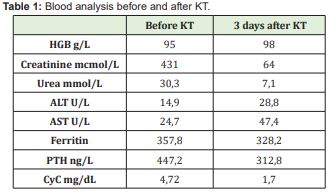
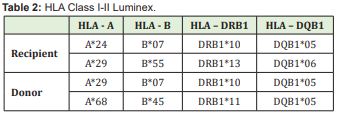
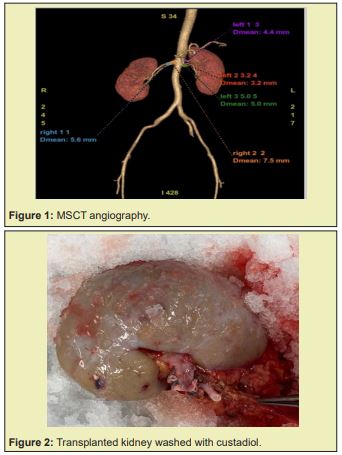
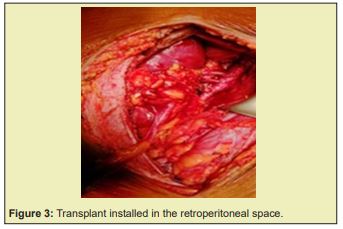
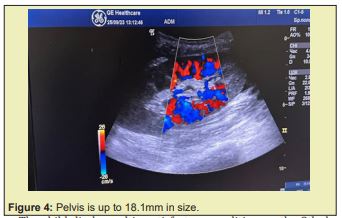
The child discharged in satisfactory condition on the 8th day after surgery, with further recommendations according to the protocol for the management of patients after KT. At the time of discharge, diuresis was 2.5-3 liters per day.
Although significant advances in conservative renal replacement therapy made, kidney transplantation is the best treatment for children with end-stage renal disease. Over the past few years, renal allograft survival and patient survival have increased due to improved care for younger patients and advances in immunosuppressive therapy, which have led to a decrease in the incidence and severity of acute rejection. Children undergoing renal replacement therapy excludes not only from school or from social activities, moreover, they have a significantly reduced quality of life compared to healthy peers. A kidney transplant for these children is the best solution, which will improve not only their physical health, but also their psycho-emotional state, giving them hope for a full life. It should note that life after transplantation also requires further observation and monitoring of lifelong immunosuppressive therapy, which is important for the further functioning of the transplanted organ. Our case may indicate that even in middle and low-income countries, kidney transplantation is possible, even with 3 renal arteries in a transplant, which is quite complex and requires certain experience and competence from the surgeon.
None.
None.
The authors declare no conflict of interest during the writing of this article.
- 1. National Kidney Foundation. K/DOQI clinical practice guidelines for chronic kidney disease: evaluation, classification, and stratification. Am J Kidney Dis. 2002;39:S1-266.
- 2. Etesami K, Lestz R, Hogen R. Pediatric kidney transplantation in the United States. Curr Opin Organ Transplant. 2020;25:343-347.
- 3. Chua A, Cramer C, Moudgil A, et al. Kidney transplant practice patterns and outcome benchmarks over 30 years: The 2018 report of the NAPRTCS. Pediatr Transplant. 2019;23(8):e13597.
- 4. Neu AM. Special issues in pediatric kidney transplantation. Adv Chronic Kidney Dis. 2006;13(1):62-69.

